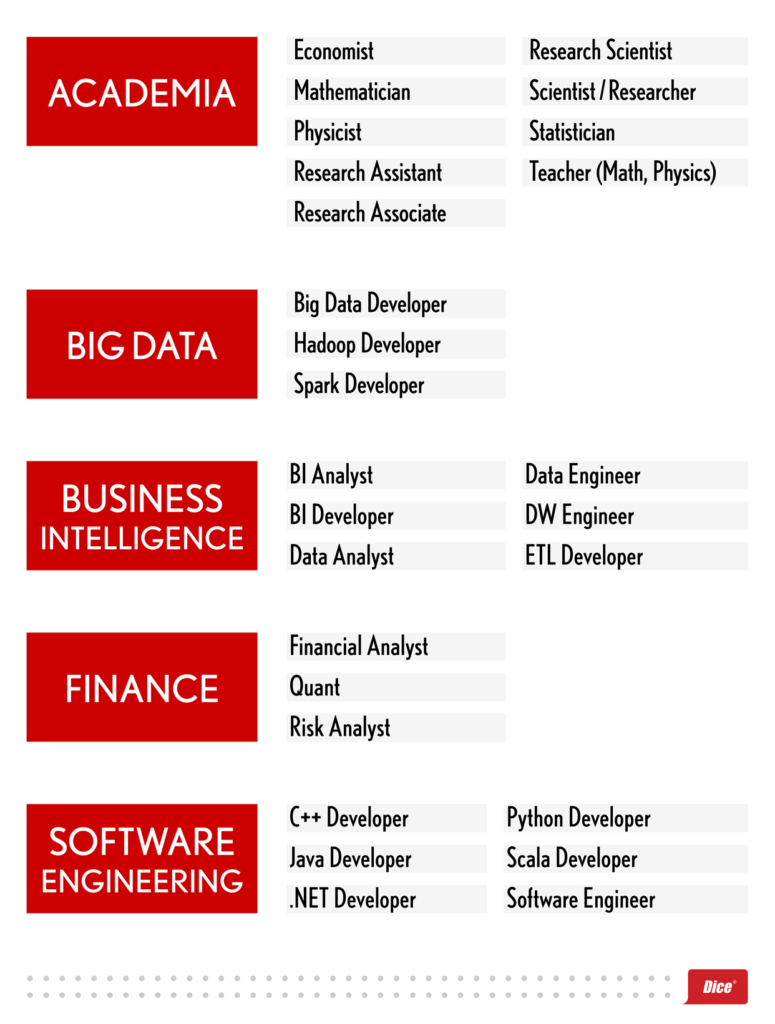What’s the ideal data scientist career path? Fortunately, there are many ways to become a data scientist—many tech pros even switch mid-career onto a data scientist track.
There’s ample reason to embark on a data scientist career. Researchers Thomas H. Davenport and DJ Patil reaffirmed in two separate studies (the second one in 2022) that data science is the “sexiest job of the 21st century,” with sustainable growth for the foreseeable future. Organizations everywhere need data scientists who can crunch huge, frequently messy datasets for crucial insights.
“By 2019, postings for data scientists on Indeed had risen by 256 percent, and the U.S. Bureau of Labor Statistics, predicts data science will see more growth than almost any other field between now and 2029,” Davenport and Patil wrote. “The sought-after job is generally paid quite well; the median salary for an experienced data scientist in California is approaching $200,000.”
But how do you actually launch a data scientist career? Let’s take a look.
Start with the Right Data Scientist Skills
HackerEarth’s 2021 Developer Survey found that data science was “the domain that is most coveted by both students and professional developers.” But actually becoming one requires a lot of training. You’ll need to know critical programming languages such as Python and SQL that are used for database management and data analytics, as well as specialized tools and skills. For example, you’ll need to become familiar with the art of data structures and analysis.
Here’s a handy list of “foundational” data science skills, drawn from Lightcast (formerly Emsi Burning Glass), which collects and analyzes millions of job postings from across the country. If you can learn these, you’re well on your way to a successful data scientist career:
- Statistics (i.e., statistical analysis)
- Data processing
- Data visualization
- Data storage
- Programming languages (Python, R, and more)
- Machine learning
- Artificial intelligence
But how do you actually learn these skills and concepts? Many schools offer complete courses in data science. If you’re interested in learning on your own, there are also lots of online tutorials and other resources. Here’s a small sampling of free ones:
- Google—Machine Learning Crash Course
- CalTech: Learning from Data
- Codementor Data Science Tutorials and Insights
- KDNuggets Tutorials
- R-bloggers Tutorial: Data Science with SQL Server R Services
- Open Source Data Science Masters
- Simply Statistics
Along with some resources that will cost you, although these come with certifications and proof of completion that you can list when applying for jobs:
- Harvard Data Science Graduate Certificate
- SimpliLearn Certificate Program in Data Science
- Berkeley Online Master’s in Data Science
- Metis Introduction to Data Science
- EdX Micromasters Program in Statistics and Data Science
- Coursera Data Science Specialization
- Udemy: Python for Data Science and Machine Learning Bootcamp
Once you’ve gained a certain degree of mastery, you should consider earning certifications, which can help with your job hunt—the presence of certifications on a resume will assure hiring managers and recruiters that you have the skills necessary for the position. Some popular certifications include:
- Certified Analytics Professional (CAP), $495 for INFORMS members, $695 for non-members, In-Person at designated test centers, Self-Paced
- Senior Data Scientist (SDS), DASCA: Cost: $775, Online, Self-Paced
- SAS Certified Data Scientist, $180 per exam, Online, Self-paced
You might also want to consider certifications in specific languages, tools, and disciplines, such as Python or machine learning; but that’s also heavily dependent on the industries and disciplines you want to focus on. Keep in mind that no matter how many certifications you earn, employers will want to test your skills via technical interviews (here are some key sample questions), and they’ll want to know you actually understand the fundamentals of data science.
Data Scientist Career Pathways
For those entering the data science industry at the start of their tech career, it’s common to take a role as a junior or associate data scientist, where you’ll learn many of the data-science ropes. From there, many data scientists embark on a career progression that eventually leads to a data architect or senior data scientist role, and from there to a director of data science role.
Others use their data-science skills to launch a career in an adjacent track, such as A.I. engineer. Whatever your level or track, learning the principles of data science, machine learning, and data analysis is always valuable.

Skills learned in other disciplines are also transferrable to data scientist. For example, economists and mathematicians work extensively with data, as do financial analysts. Software engineers often learn the tools crucial to data scientists. In other words, a mid-career transition to data science is certainly possible; here are some common roles that transition to a data science career:

Whatever data scientist career path you choose, keep in mind you’ll need “soft skills” such as communication and empathy to effectively convey your analysis and results to all stakeholders throughout your organization and beyond. With the right mix of soft and technical skills, your chances of success as a data scientist will only rise.
Related Data Scientist Jobs Resources:



